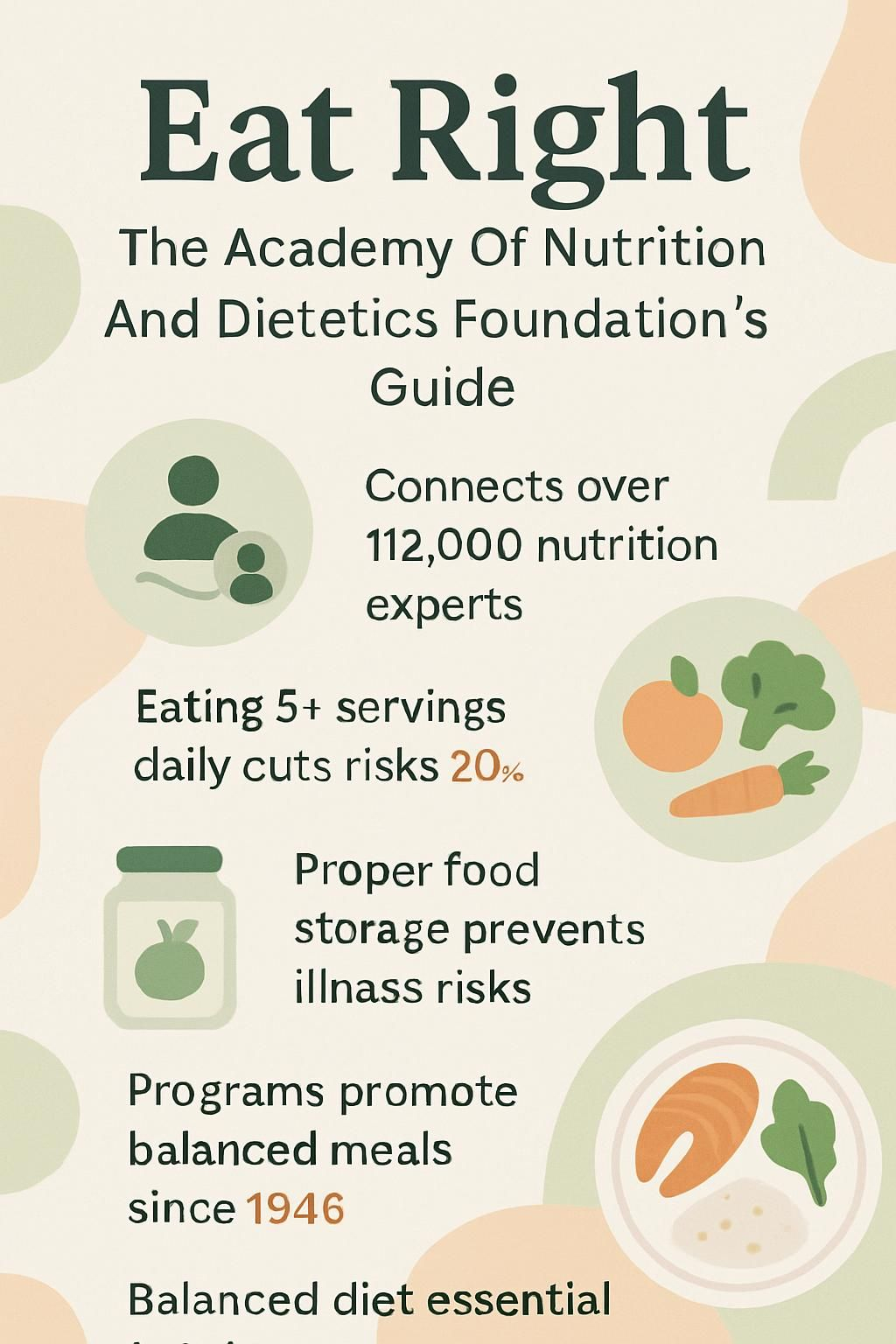Eat Right: The Academy Of Nutrition And Dietetics Foundation’s Guide
Our Nutrition Assistant AI Suite will transform your body. You will lose fat, get toned, and build muscle. Gain confidence and optimal health.
Making healthy food choices can feel hard. The Academy of Nutrition and Dietetics shares science-based tips to help you eat right and build steady habits.
This guide shows simple ways to improve health, choose smart foods, store them safely, and help children enjoy good nutrition. Learn how small steps add up each day.
Key Takeaways
- The Academy of Nutrition and Dietetics brings together more than 112,000 experts to share evidence-based guidance on disease prevention, meal planning, and public health.
- Eating at least five servings of fruits and vegetables daily may lower heart disease risk by about 20 percent, based on current research.
- Safe storage, using sealed containers at or below 40°F, and preventing cross-contamination reduce foodborne illness risk, per USDA guidance.
- Programs such as the National School Lunch Program and WIC promote balanced meals with fruits, vegetables, grains, dairy, and protein across the United States.
- Balanced eating patterns that include whole grains, lean proteins, healthy fats, and calcium-rich choices support health across all life stages.

About the Academy of Nutrition and Dietetics

The Academy of Nutrition and Dietetics leads national efforts to improve food and nutrition for adults and children. Registered dietitian nutritionists develop practical toolkits that support healthy eating, school meals, and evidence-based nutrition care.
What is the mission and vision of the Academy of Nutrition and Dietetics?
The Academy’s mission focuses on improving health and nutrition for everyone through research, education, and advocacy. Members share science-based resources to help you make confident food decisions each day.
“Empowering individuals to achieve optimal health through food and nutrition” reflects this commitment.
More than 112,000 credentialed practitioners support this work. These include registered dietitian nutritionists, or RDNs, and nutrition and dietetics technicians, or NDTRs. The vision is a world where all people enjoy healthy eating, supported by qualified professionals who use evidence-based practice across clinical nutrition, public health, school meal programs, medical nutrition therapy, telehealth, agriculture, research, continuing professional education, and equity-focused programs that reduce hunger and chronic disease risk.
How does the Academy promote nutrition education?
You can access reliable education through Academy resources and events. The Food and Nutrition Conference and Expo, or FNCE, brings practitioners together to discuss hot topics in nutrition, dietary guidelines, and effective nutrition interventions.
Trusted guides on meal planning, healthy foods, food safety, and managing health conditions are available on eatright.org and eatrightpro.org. A searchable database helps you find a nutrition expert near you for personalized support.
Campaigns highlight prevention, such as National Breast Cancer Awareness Month in October. The Academy also supports school breakfast efforts and collaborates with the United States Department of Agriculture to promote healthy diet choices. I joined a live web conferencing session that shared useful budget-friendly meal ideas I could use the same week.
These resources reach all ages and backgrounds and aim to improve health and well-being through better food and nutrition education.
How does eating right impact your health?
Eating right builds strong habits and supports long-term wellness. Balanced foods and beverages can reduce your risk of heart disease and other chronic conditions.
What are the health and wellness benefits of eating right?
Choosing nutrient-dense foods from every food group supports a healthy weight, strengthens your immune system, and boosts energy. Studies suggest that five or more daily servings of fruits and vegetables can cut heart disease risk by about 20 percent.
Whole grains add fiber that helps digestion and supports steady blood sugar, which may reduce the risk of type 2 diabetes. Practicing portion control and planning balanced meals help you avoid excess sugar and sodium.
As a busy parent, using MyPlate guidelines made weeknight planning easier and improved our family’s energy. Patterns like the Mediterranean diet add healthy fats and lean proteins that support lifelong health.
How can nutrition help prevent diseases?
Nutrition acts like a shield for your body. A balanced diet lowers the risk of type 2 diabetes, heart disease, and some cancers.
Variety is key. Fruits, vegetables, and whole grains strengthen the immune system and help the body fight infections. October’s breast cancer awareness efforts remind us that eating well and staying active play important roles in prevention.
Skipping breakfast and not getting enough sleep raise the risk of weight gain and diabetes, especially in children. Offering a nutritious breakfast improves alertness and behavior in class. Programs like the Summer Food Service Program and WIC improve access to healthy foods and nutrition education.
Small daily choices, such as adding an extra fruit, switching to whole grain bread, or drinking water instead of soda, help lower risk over time.
Healthy eating is not a diet, it is a lifestyle that prevents disease and supports your body’s best performance.
Understanding the main food groups
Eating from all the main food groups supports a healthy pattern and your daily activity. Each group provides a different set of nutrients your body needs at different life stages.
What are the benefits of eating fruits and vegetables?
Fruits and vegetables deliver vitamins, minerals, and fiber. These nutrient-dense foods link to lower risk of heart disease and certain cancers.
USDA guidance recommends filling half your plate with fruits and vegetables at meals. Good storage and handling protect freshness and nutrients while lowering the chance of foodborne illness at home.
Properly stored produce stays fresh longer and reduces waste. Aim for a rainbow of colors to cover a wide range of nutrients.
Why include whole grains in a balanced diet?
Whole grains provide fiber, B vitamins, iron, magnesium, and selenium. Research shows that eating more whole grains is linked with lower risk of heart disease and type 2 diabetes.
Choices like brown rice, quinoa, barley, and oats support digestive health and steady energy. Make at least half of your daily grains whole. Many people feel fuller longer with whole wheat pasta or oatmeal compared with refined grains.
These options improve overall nutrition without relying on a fiber supplement.
What are the best protein sources?
Protein builds and repairs tissues. Lean proteins such as chicken, turkey, fish, eggs, tofu, and low-fat dairy offer key nutrients with less saturated fat.
Beans, lentils, nuts, and seeds provide excellent plant-based protein. Using both animal and plant sources can meet needs at every age and preference.
Access matters too. Community programs, including SNAP and breastfeeding support, help families find nutrient-rich protein choices that fit their budgets and cultures.
What are the options for dairy and its alternatives?
Dairy foods and fortified alternatives supply calcium, vitamin D, protein, and potassium. These nutrients support bones and muscles at every age.
Milk, cheese, and yogurt are common options. Alternatives like soy milk and almond milk work well for people who avoid lactose or animal products. Choose fortified versions that list calcium and vitamin D on the label.
In my kitchen, I keep fat-free cow’s milk and unsweetened soy beverages so guests with allergies have an easy option. Checking the Nutrition Facts label helps you keep key nutrients in your diet.
How can I handle food safely at home?
Safe food handling protects your health and your family’s meals. These simple steps keep germs away and preserve quality.
How should food be stored properly?
Proper storage helps prevent food poisoning and waste. USDA guidelines offer these steps:
- Refrigerate perishable foods within two hours of purchase or cooking to slow bacterial growth.
- Keep the refrigerator at or below 40°F, 4°C, and the freezer at 0°F, -18°C, to maintain freshness.
- Use airtight containers or sealed bags for leftovers to reduce spoilage and keep flavors.
- Place raw meats, poultry, and seafood on the lowest shelf to prevent juices from dripping onto other foods.
- Store fruits and vegetables in clean crisper drawers to help preserve texture and vitamins.
- Label containers with dates so older items get used first.
- Keep dairy away from strong odors like onions, and use closed containers.
- Freeze bread, cooked grains, and extra meals you will not eat soon to save money and cut waste.
- Wash reusable containers with hot, soapy water after every use.
- Check expiration dates and also look for spoilage, such as discoloration or off smells, before eating.
Safe storage protects health, preserves nutrients, and reduces household waste.
How can I avoid cross-contamination in the kitchen?
Cross-contamination spreads germs between foods and surfaces. These habits lower your risk:
- Wash hands with soap and water for 20 seconds before and after handling raw foods.
- Use separate cutting boards for raw meat and for produce to avoid contamination.
- Clean counters, utensils, and equipment with hot, soapy water after each use.
- Keep raw foods apart from cooked and ready-to-eat foods during prep and storage.
- Store perishables in sealed containers at or below 40°F to keep food safe.
- Do not place cooked food on plates that held raw meat or eggs without washing them first.
- Change dish towels and sponges often since they can hold bacteria.
Good storage and separation habits work together to keep your kitchen safe.
How to plan and prepare balanced meals?
Balanced meals are built with simple, repeatable steps. A plan reduces stress and helps you support healthy eating every day; read more for easy ways to start.
How to create balanced meals?
Follow these basics from Academy guidelines to meet your needs:
- Include all five food groups, fruits, vegetables, grains, proteins, and dairy or fortified alternatives.
- Make half your plate fruits and vegetables. Diets rich in produce, including Mediterranean-style eating, are linked with lower heart disease risk.
- Choose whole grains like brown rice or whole wheat bread to add fiber and improve fullness.
- Pick lean proteins such as chicken, fish, beans, tofu, or eggs for essential amino acids without excess saturated fat.
- Select low-fat dairy or fortified alternatives, like yogurt or soy milk with calcium and vitamin D, to support strong bones.
- Limit highly processed foods that are high in added sugar and sodium.
- Include healthy fats in small amounts from nuts, seeds, avocado, or olive oil.
- Use herbs and spices instead of salt to build flavor.
- Adjust portions to your age and activity level using MyPlate.gov or advice from a registered dietitian nutritionist.
- Meal prep saves time. As a parent, planning two dinners ahead made weeknights calmer and more balanced.
How can meal planning save money?
Planning before you shop cuts waste and lowers costs. A written meal plan and list reduce impulse buys and fast-food spending.
The Academy recommends reading labels and comparing prices. Many families waste close to one-third of purchased food in the United States, according to USDA estimates. Checking your pantry first and planning leftovers for lunches can prevent waste.
At home, a weekly list and a quick pantry check trimmed my grocery bill by about twenty dollars. Freezing extra portions stretches savings even more.
Incorporating cultural foods into your diet
Bringing cultural foods to the table adds flavor and nutrients. It also makes healthy eating more enjoyable and sustainable.
Why is diversity important in food options?
Diverse food choices help cover nutrient needs. Different cuisines highlight different strengths, like tofu for protein in many Asian dishes or olive oil and vegetables in Mediterranean cooking.
A varied plate supports balance and keeps meals interesting. The Academy encourages including traditional foods to improve dietary variety and nutritional adequacy.
What are the nutritional values of traditional cuisines?
The Mediterranean pattern features olive oil, fish, vegetables, grains, and legumes. These foods bring fiber, vitamins A and C, omega-3 fats, and lean proteins. Studies link this pattern to lower rates of heart disease and type 2 diabetes.
Japanese meals often include seaweed and fermented soy, which add minerals and protein. Many Latin American plates pair beans with corn or rice to create complete proteins and add B vitamins.
When I rotated recipes from Italy and Japan across a month, my energy improved after adding more whole foods from these traditions. Using strengths from several cuisines can help you meet health goals without losing the foods you love.
What nutrients are essential for different life stages?
Nutrient needs change as you grow, have children, and age. A few adjustments help your body at each stage.
What nutrition is needed during pregnancy?
Pregnancy raises needs for calories and key nutrients. Experts suggest an extra 340 to 450 calories a day in the second and third trimesters for your baby’s growth.
Aim for at least 600 micrograms of folic acid from leafy greens and fortified grains. Iron needs rise from 18 milligrams to 27 milligrams daily, so include beans and lean meats. Drink enough water to stay hydrated as blood volume increases.
Many providers recommend prenatal vitamins if your diet falls short. A balanced plate from all food groups supports maternal and fetal health.
What are the nutritional needs of children and teens?
Growing bodies need protein for muscles and carbohydrates for energy. Calcium and vitamin D from dairy or fortified alternatives strengthen bones. Iron supports healthy blood and prevents fatigue.
The National School Lunch Program provides balanced meals with fruits, vegetables, grains, and protein. Regular breakfast improves alertness and has been linked with better academic performance.
Smart snacks, such as yogurt with fruit or whole grain crackers with cheese, fill gaps between meals. When my nephew packed colorful lunches with more fruits and vegetables, he became more curious about trying new foods.
What dietary requirements do older adults have?
Older adults often need fewer calories but more nutrients per bite. Focus on leafy greens, berries, beans, and whole grains for vitamins, minerals, and fiber.
Hydration is vital since thirst can fade with age. Calcium and vitamin D support bone health, so choose low-fat dairy or fortified plant milks and leafy greens. Include lean proteins from fish, poultry, or legumes to help protect muscle.
Seek help from an RDN if chewing, digestion, or access to food is a challenge. Small changes can make meals easier and more nutritious.
How does nutrition support fitness?
Food fuels movement. The right mix helps you power through workouts and recover faster.
What nutrition is best for physical activity?
Active children and adults need enough calories, protein, vitamins, and minerals to match their activity. Base meals on whole grains, lean proteins, fruits, vegetables, and healthy fats such as olive oil. The Mediterranean style fits well here.
Hydration matters. Drink water before you start and sip 7 to 10 ounces every 10 to 20 minutes while exercising, as current guidelines suggest. After activity, refuel with a snack that combines carbs and protein, such as yogurt with fruit or a turkey sandwich.
Which nutrients improve athletic performance?
Protein supports muscle repair after exercise. Whole grains provide steady energy as they release glucose slowly.
Fruits and leafy greens deliver vitamins and minerals like iron and potassium that support oxygen transport, nerve function, and hydration. Timing helps as well. A protein-rich snack within 30 minutes after exercise can support muscle recovery.
During my 5K training last summer, whole grain toast with peanut butter before runs improved endurance. A glass of chocolate milk afterward helped me bounce back for the next day.
What are some healthy recipes for everyday living?
Healthy food can be quick and tasty. These ideas use simple ingredients you can find in most stores.
What are easy and nutritious breakfast ideas?
A balanced breakfast supports focus and learning, especially for children. Include several food groups for steady energy.
- Oatmeal with nuts and berries for whole grains, healthy fats, and vitamins.
- Greek yogurt parfait with sliced bananas and whole-grain cereal for protein, calcium, fiber, and potassium.
- Scrambled eggs with spinach and tomatoes on whole-wheat toast for protein, iron, and vitamin C.
- Smoothie with milk or fortified plant milk, frozen fruit, chia seeds, and peanut butter for calcium and antioxidants.
- Breakfast wrap with black beans, avocado, cheese, and salsa in a whole-grain tortilla for fiber and heart-healthy fats.
- Overnight oats made with rolled oats and low-fat milk or soy milk, plus chopped apples and raisins.
- Apple slices with nut butter and a hard-boiled egg for protein and vitamin E on busy mornings.
- Whole-grain muffins with grated carrots or zucchini to add nutrients while keeping sugar low.
These breakfasts fit evidence-based guidance for quick, nutrient-dense meals.
What innovative salads and side dishes can I try?
Salads and sides can carry whole grains, lean proteins, and colorful produce. Try these combinations:
- Leafy greens with mango, grilled chicken, and quinoa for vitamins A and C plus fiber.
- Roasted sweet potatoes with black beans, corn, red peppers, and lime-cilantro dressing for potassium and plant protein.
- Farro with cherry tomatoes, spinach, feta, and chickpeas for whole grains and calcium.
- Spinach with sliced strawberries and walnuts for antioxidants and healthy fats.
- Brown rice with steamed broccoli, carrots, edamame, sesame seeds, and soy sauce for an Asian-inspired bowl.
- Greek yogurt tzatziki as a protein-rich dip for cucumber rounds or carrot sticks.
- Arugula with roasted beets, orange segments, goat cheese, and pumpkin seeds for vitamin C and folate.
- My family enjoys cooked barley with diced apples and pecans for a fiber-rich autumn side.
Rotating sides across the week keeps meals fresh and balanced.
What are healthy snack options for all ages?
Smart snacks combine protein, healthy fat, and fiber. These choices work for kids, teens, and adults:
- Apple slices with natural peanut butter for fiber and healthy fat.
- Greek yogurt with berries for protein and antioxidants.
- Whole grain crackers with low-fat cheese for complex carbs and calcium.
- Trail mix with nuts, seeds, and a small amount of dried fruit, portioned in small containers.
- Raw vegetables with hummus for fiber, plant protein, and healthy fats.
- Hard-boiled eggs for high-quality protein.
- Fruit smoothies with milk or fortified alternatives to boost vitamin D and calcium without added sugars.
- Air-popped popcorn with a light sprinkle of spices instead of salt.
- Turkey and avocado roll-ups for lean protein and unsaturated fat.
- Cottage cheese with pineapple chunks for calcium and vitamin C.
- Banana halves with almond butter for a quick after-school option.
These snacks help you include all food groups across the day.
How can I promote healthy eating in children?
Kids learn from what they see and taste. Simple routines and patient coaching build habits that stick.
How to encourage healthy eating habits in kids?
Parents and caregivers can guide kids with clear steps and a positive tone:
- Offer a variety of colorful fruits and vegetables each day.
- Involve children in planning and cooking to build skills and interest.
- Share family meals often, even on sports nights, to reinforce healthy patterns.
- Serve breakfast daily to support attention and learning.
- Keep consistent meal and snack times to limit grazing on low-nutrient foods.
- Use playful presentations, such as fun shapes, to make healthy foods appealing.
- Work with school staff if your child has food allergies, and follow recommended safety steps.
- Model balanced eating yourself so kids see healthy choices in action.
- Use Academy resources for age-appropriate tips and ideas.
- Include cultural favorites within balanced menus to build acceptance and pride.
- Share your progress toward healthier habits to show change is possible at any age.
What are creative meal ideas for children?
Fresh ideas make nutritious meals more interesting. These simple options are easy to pack or serve at home:
- Whole grain sandwiches with lean turkey, sliced veggies, or hummus.
- Fruit kabobs with strawberries, grapes, and melons for color and vitamins.
- Breakfast burritos with eggs, spinach, and cheese in a whole wheat tortilla.
- Build-your-own salad bar with lettuce, black beans, cherry tomatoes, grilled chicken, and low-fat cheese.
- Mini pizzas on whole wheat pitas with tomato sauce and vegetable toppings.
- Greek yogurt parfaits with berries and granola for a satisfying snack.
- Vegetable wraps with grated carrots, cucumbers, and bell peppers.
- Themed bento boxes with bite-sized sandwiches, fruit slices, roasted chickpeas, and veggie sticks.
- Mini egg muffins with chopped broccoli or spinach for protein and iron.
- In my family, letting kids choose taco toppings made them excited to add new vegetables each week.
Where can nutrition experts find resources?
Staying current supports quality care. Trusted organizations and journals provide tools for evidence-based practice.
How to locate a qualified nutrition professional?
The Academy of Nutrition and Dietetics’ online directory helps you search for credentialed food and nutrition professionals by location and specialty. More than 100,000 experts are listed.
Personalized support is available if you need help with a medical condition or lifestyle goal. I used the directory to find a local specialist who helped me lower my cholesterol with an evidence-based plan.
Look for the RDN credential after a name. It signals national training and standards recognized by the Academy.
What opportunities exist for continuing education in nutrition?
The 2025 Food and Nutrition Conference and Expo offers education sessions and networking for nutrition and dietetics professionals. The Academy also provides ongoing online workshops, hands-on seminars, and digital resources.
These programs cover new research and practical skills. Regular learning helps you stay current and maintain credentials.
What are the latest findings in nutrition research?
Continuing education helps you share accurate, science-based information with your community. The Academy’s Nutrition Fact Check initiative highlights current findings in clear language.
Insufficient sleep is linked with weight gain and higher risk of type 2 diabetes, especially in children. Structured eating routines and adequate sleep are associated with a lower likelihood of obesity.
Balanced diets that include fruits, vegetables, and whole grains reduce the risk of chronic diseases. These updates help you choose healthier patterns and guide others with confidence.
Insights and initiatives from the Academy
The Academy advances food safety, reduces waste, and supports healthy school meals. These efforts make healthy eating easier at home and in communities.
How does the Academy ensure produce safety?
Clear safety steps help prevent illness from fresh produce. Rinse fruits and vegetables under running water before eating or cooking.
CDC estimates suggest that about 48 million people in the United States get sick each year from contaminated food. Keeping raw foods separate from ready-to-eat items limits cross-contamination. Most fruits and vegetables store best between 32°F and 40°F in the refrigerator.
Regular handwashing and clean surfaces reduce harmful bacteria such as Salmonella or E. coli. Using these practices lowers your risk of getting sick.
What strategies help minimize food waste?
USDA data indicates that about one-third of food goes to waste each year nationally. Planning meals and shopping with a list reduce this waste at home, in schools, and in restaurants.
Store leftovers in airtight containers and refrigerate perishables promptly. Use the “first in, first out” method, using older products before newer ones. Educational resources from the Academy share practical guidance on smart storage and planning.
In my kitchen, labeling pantry items with purchase dates helped me use food on time and cut waste from forgotten items.
What initiatives support healthy school breakfasts?
The National School Lunch Program, established in 1946 by the USDA, supports school breakfasts across the country. These meals provide balanced nutrition for students who need a strong start.
Schools now feature whole grains, lean proteins, fruits, and low-fat dairy on menus. The Academy helps schools and families choose appealing options such as oatmeal with fruit or yogurt parfaits.
Student taste tests and recipe contests make nutritious foods more exciting. Involving students in menu planning improves participation and satisfaction.
Conclusion
Following guidance from the Academy of Nutrition and Dietetics helps you eat right with confidence. You learn how balanced patterns support health at every age, how safe storage cuts illness risk, and how meal planning saves time and money while adding variety.
Use trusted resources to separate facts from myths. Reach out to a registered dietitian nutritionist if you need support for medical conditions, sports goals, or special diets. Small, steady changes lead to lasting benefits for you and your family.
This information is for general education. For personal medical advice, consult a registered dietitian nutritionist or your healthcare provider.
FAQs
1. What is the main goal of Eat Right: The Academy Of Nutrition And Dietetics Foundation’s Guide?
The guide aims to help people make informed food choices using evidence-based nutrition advice from registered dietitians and health experts. It provides clear steps for building balanced meals, reading nutrition labels, and understanding portion sizes.
2. How does the guide use data to support healthy eating recommendations?
The foundation uses research studies and national dietary surveys to back its advice. For example, it lists daily recommended amounts of fruits, vegetables, grains, protein foods, and dairy in easy-to-read tables so readers can compare their intake with expert guidelines.
3. Can you share a personal application of this guide’s tips?
After following the meal planning section from the guide last year, I started preparing weekly grocery lists based on suggested food groups. This change helped me eat more whole grains and fresh produce while reducing my intake of processed snacks.
4. Why should someone trust information from this foundation’s guide?
Registered dietitians review all content before publication; each recommendation comes from peer-reviewed scientific studies or government sources like the Dietary Guidelines for Americans 2020-2025 (USDA). Readers can rely on these facts when making decisions about their diets.
Summary:
Eat Right: The Academy Of Nutrition And Dietetics Foundation’s Guide offers practical tools rooted in science for anyone seeking better nutrition habits. Its focus on credible data ensures reliability while real-life examples show how small changes lead to healthier outcomes over time.







